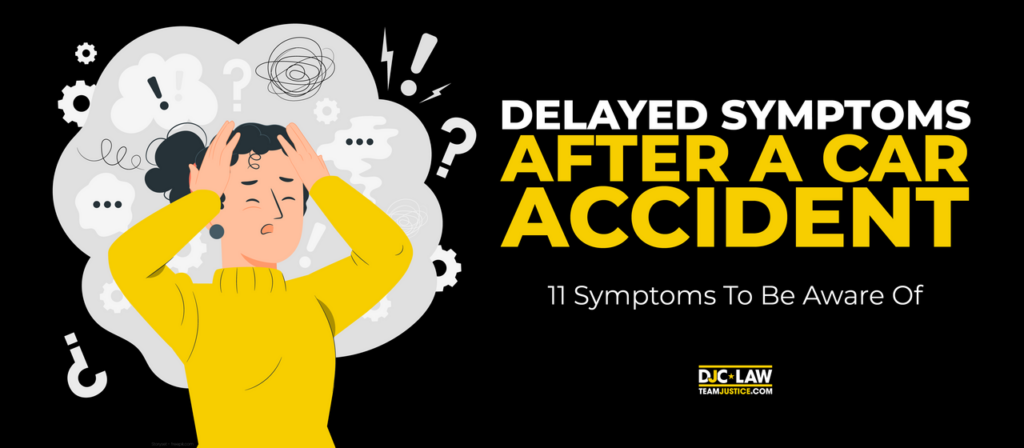
Just because you walked away from a car accident feeling great doesn’t mean you’re out of the woods yet. Adrenaline does strange things, and one of them is hiding injuries until later. It’s not uncommon for car accident victims to feel pain and other symptoms hours, days, or even weeks after an accident.
Approximately 5.1 million medically consulted injuries were reported in 2023 from auto accidents in a National Safety Council study. Immediate medical consultations are important, but many injuries won’t be diagnosed in an examination straightaway. Instead, you might have to return later when symptoms arise.
In this guide, we’ll cover some of the serious injuries that might take time to show, including what to do and the legal implications.
Key Takeaways
Hidden injuries are injuries that don’t appear in the immediate aftermath of an accident. Some may appear in hours, days, or weeks after an accident.
Major delayed injury symptoms requiring immediate medical attention include headaches, back pain, neck pain, internal bleeding, blood clots, and numbness or tingling.
Psychological injuries may also arise as delayed injuries from an accident, including Post-Traumatic Stress Disorder (PTSD).
Your body’s natural adrenaline response inhibits symptoms in the immediate aftermath, which is why the trauma doesn’t tend to arise until long after you’ve walked away from an accident.
Your personal injury lawyer can claim for delayed injuries as part of your case. Speak to a lawyer to ensure you get the maximum settlement.
What are Hidden Injuries?
Hidden injuries are injuries that aren’t immediately apparent after an accident. Instead, the symptoms may take hours, days, or weeks to show.
Even in the absence of broken bones or visible injuries, the effects of an adrenaline rush can delay your awareness of internal or soft tissue damage.Any strange sensation after a crash, like tension headaches, blurred vision, or abdominal pain, should prompt a visit to a medical professional.
Don’t underestimate the impact of passing off symptoms because the Impact Medical Group found 55% of people involved in rear-end crashes were still symptomatic eight years later. Prompt medical treatment ensures that you retain your quality of life and avoid issues like chronic pain.
Due to the nature of some hidden injuries, including internal bleeding and traumatic brain injuries (TBIs), not reacting to symptoms could leave you at risk of long-term damage or even death.
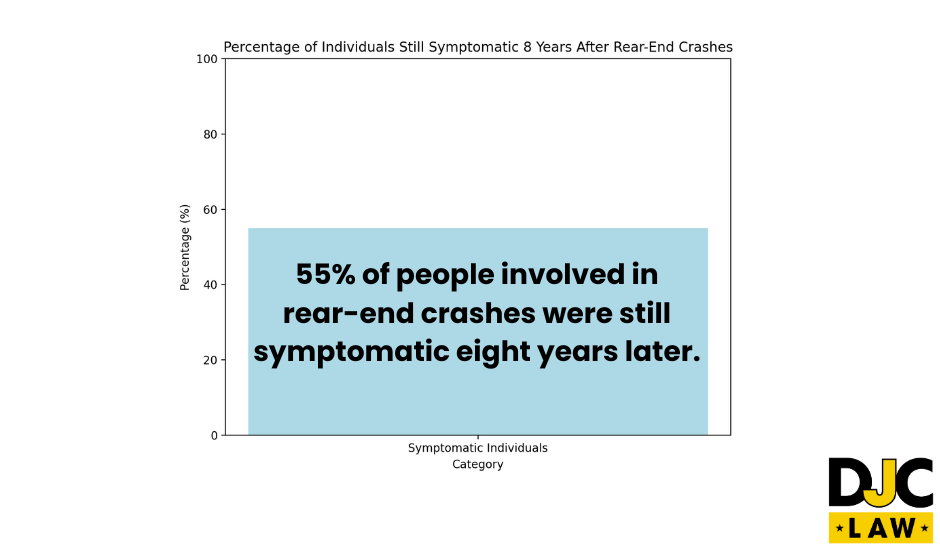
How Long After a Car Accident Can Injuries Appear?
It’s common for delayed pain to emerge hours, days, or even weeks post-accident. Common injuries that may take a while to appear include internal bleeding, whiplash, concussions, and herniated disks.
What is considered a delayed onset injury? Florida Medical Pain Management classifies a delayed onset injury when symptoms appear 24-48 hours after an accident. Some people mistakenly believe that if you make it through the first 24 hours, you’ve escaped from issues like whiplash, but this isn’t strictly true.
We recommend going to a medical facility immediately after an accident, but it’s critical to monitor your own health for a few weeks after your accident. Anything out-of-the-ordinary, including headaches, should be a red flag for you to schedule an appointment with your doctor.
Don’t ignore delayed injuries. Contact DJC Law today for a free consultation and get the legal support you need to protect your health and your case.
What Delayed Symptoms Should You Look For After a Car Accident?
Delayed onset symptoms often manifest physically and mentally. Common types of delayed symptoms include back, neck and shoulder pain. You may also suffer from regular headaches and sleep disturbances.
Delayed symptoms aren’t an immediate signpost toward a specific condition. Symptoms are often confusing, and you might pass off symptoms as something that’ll clear up. Granted, evidence backs up this assertion, with Lippincott reporting 59% of neck injury symptoms resolved within 12 days.
Here’s a list of some of the most common delayed injury symptoms you shouldn’t ignore.
1. Delayed Vertigo
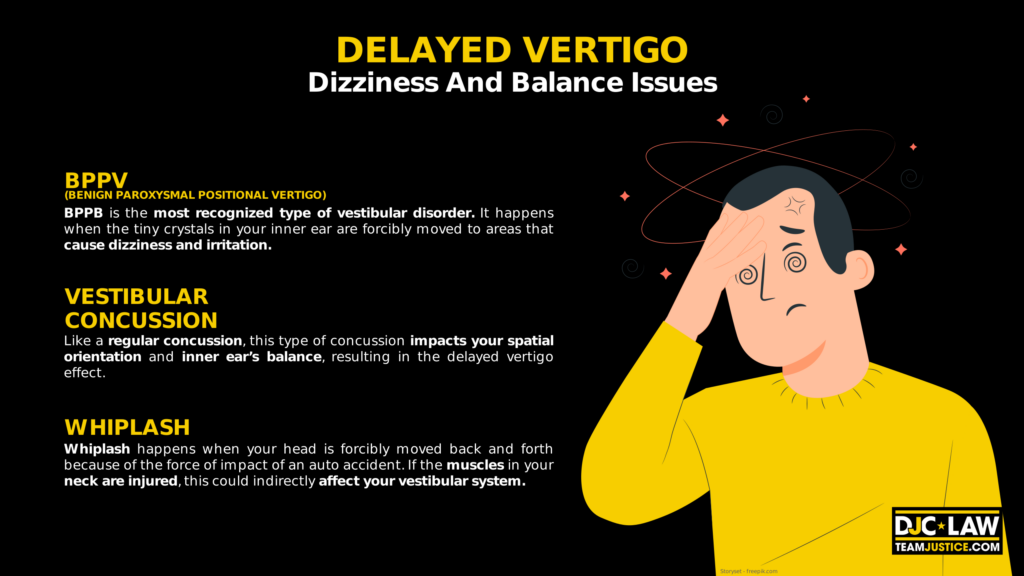
Delayed vertigo is characterized by dizziness and balance issues after a car accident. It’s often a sign that the vestibular system has sustained damage or that you have a concussion. Some of the symptoms of delayed vertigo include nausea, headaches, and balance issues.
Some of the causes of your symptoms include:
Benign Paroxysmal Positional Vertigo (BPPV) – BPPB is the most recognized type of vestibular disorder. It happens when the tiny crystals in your inner ear are forcibly moved to areas that cause dizziness and irritation.
Vestibular Concussion – Like a regular concussion, this type of concussion impacts your spatial orientation and inner ear’s balance, resulting in the delayed vertigo effect.
Whiplash – Whiplash happens when your head is forcibly moved back and forth because of the force of impact of an auto accident. If the muscles in your neck are injured, this could indirectly affect your vestibular system.
In short, ignoring delayed vertigo is a problem because there’s a high risk of falling over and causing yourself further injury.
2. Whiplash
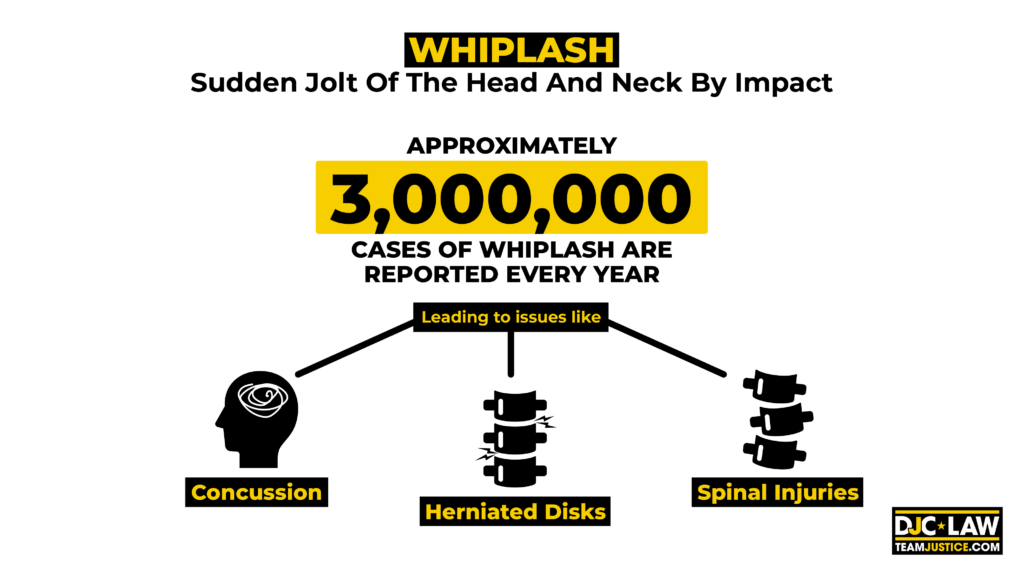
Whiplash is one of the most common car accident injuries. It’s caused by the sudden jolt of the head and neck as it’s rocked back and forth by an impact. It often leads to issues like concussion, herniated disks, or a spinal injury.
Approximately three million cases of whiplash are reported every year in a report from Brookdale Health. For most people, whiplash is painful, but that’s about it. Rest is often enough to clear up symptoms, but severe cases of whiplash could be hiding other serious issues with your neck and back.
Allowing whiplash to disappear without medical supervision potentially leaves you open to chronic pain and limited mobility.
What is Whiplash?
Whiplash is a neck injury caused by a sudden and abrupt back-and-forth movement of the head. Also known as neck strain or neck strain, whiplash can damage the ligaments, disks, and joints in your neck. The most common symptoms are pain and stiffness.
Symptoms of whiplash may be delayed for 24-48 hours after your auto accident. You’ll usually see symptoms like the following in the first few days:
Neck pain
Neck stiffness
Headaches
Lower back pain
Dizziness
Tingling/numbness in the arm/hand
Blurry vision
Tinnitus
Fatigue
Whiplash has so many varying symptoms that diagnosing it without a proper medical examination is impossible. According to WebMD, whiplash is a diagnosis of exclusion, meaning a doctor won’t look for signs of whiplash but rule out all other potential conditions first.
3. Headaches or Concussion
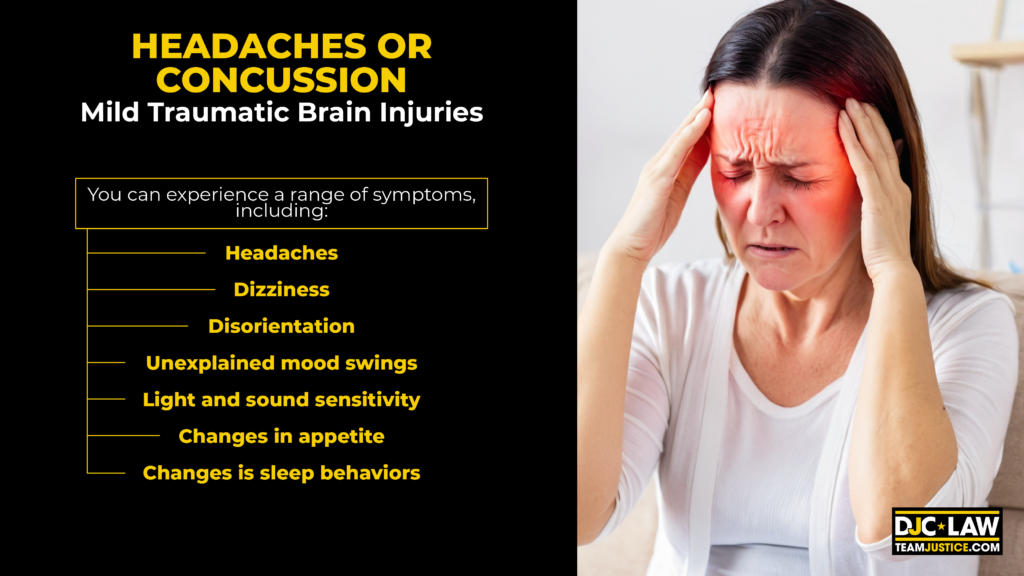
Concussions are a type of mild traumatic brain injury caused when a sudden movement of the head forces the brain to strike the inside of your skull. These can occur even if your head doesn’t actually collide with an object.
Concussions can be mild to severe and can cause serious problems in the long term, as we’ve seen from former sports stars in the NFL. You can experience a range of symptoms, including:
Headaches
Dizziness
Disorientation
Unexplained mood swings
Light and sound sensitivity
Changes in appetite
Changes in sleep patterns
- Memory loss
Concussions are challenging to diagnose, especially since minor concussions may show minimal symptoms. According to the Virginia Department of Health, the vast majority of people will fully recover from concussion. Typically, a single concussion isn’t enough to cause permanent brain damage, but it needs to be checked out by a doctor immediately.
4. Neck Pain
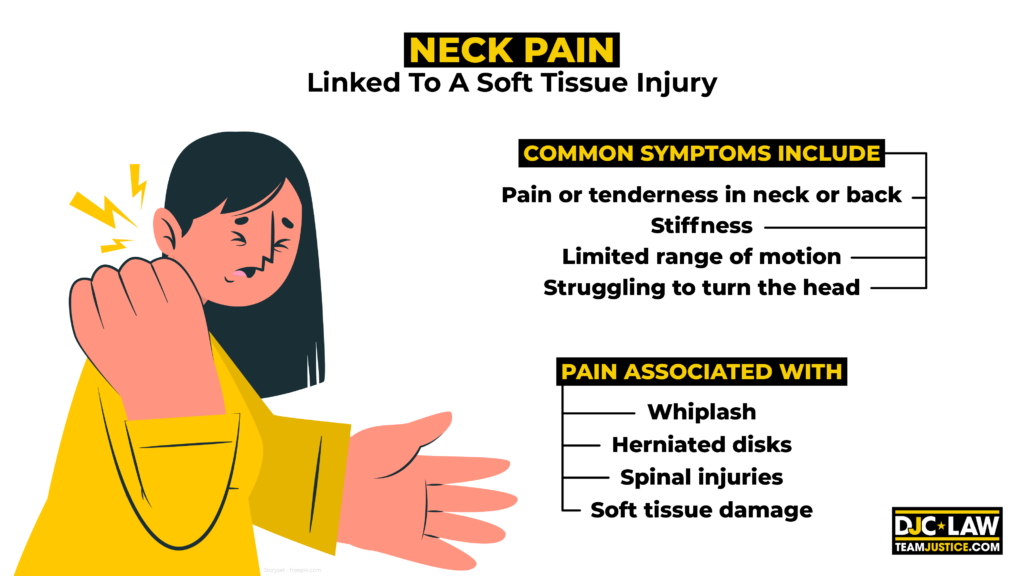
Neck pain after a car accident is linked to whiplash, herniated disks, spinal injuries, and other soft tissue damage. The sudden whipping motion of the head results in neck pain as the ligaments and muscles become damaged by the sudden force.
Any neck pain after an accident usually means you’ve got a soft tissue injury. Alongside the pain in the neck, the fact that the body is forced backward while the head is shoved forward means that neck pain could also hide other problems elsewhere.
Common symptoms include pain or tenderness in your neck or back, stiffness, and limited range of motion. Severe neck injuries often mean that people struggle to turn their heads at all. Ignoring these symptoms often means long-term and chronic pain if left untreated..
5. Back Pain
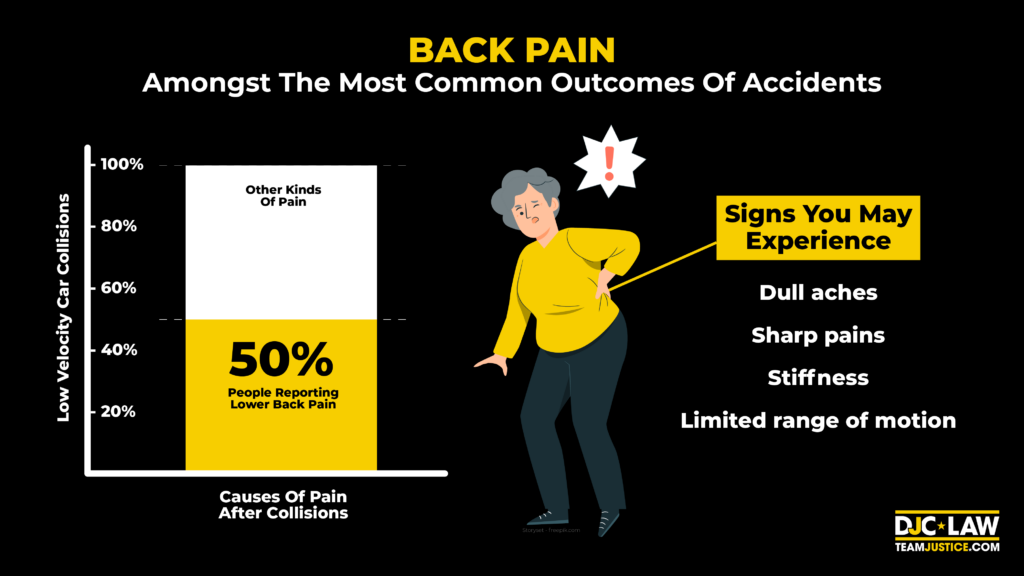
Back pain is any type of pain that occurs after a car accident. Your spine includes your neck, meaning the whipping motion of the neck radiates down the back, causing inflammation, nerve compression, and fractures.
Your back pain could be linked to slipped/herniated disks in your neck, cervical vertebrae fractures, and even more serious spinal cord injuries. However, severe back pain would likely be detected at the scene or during your initial medical examination.
Back injuries are among the most common outcomes of auto accidents, with up to 50% of people in low-velocity collisions reporting lower back pain in a study published by ResearchGate.
Some of the signs you may experience from a back injury include the following:
Dull aches
Sharp pains
Stiffness
Limited range of motion
Your doctor may recommend undergoing an MRI or an x-ray to get a better look at the damage to your back before determining a treatment plan or settling on a specific diagnosis.
How long does it take for back pain to go away after a car accident?
The duration of back pain depends on what’s causing it. A cervical herniated disk injury (where the soft gel-like material of the spinal disk bulges, putting pressure on the surrounding nerves) may take up to six weeks for the pain to disappear, whereas most strains and sprains disappear after two weeks. In contrast, severe whiplash could take up to three months to subside.
According to Portland Urgent Care, they categorize back pain like so:
Acute Back Pain – The initial phase lasts from a few days to a few weeks. Most people with acute pain need standard medical intervention.
Subacute Back Pain – These accident victims need four to twelve weeks to recover, even though the pain is often less intense. However, subacute back pain is longer-lasting, thus requiring additional treatment options.
Chronic Back Pain – Chronic back pain extends beyond 12 weeks and usually indicates underlying issues, which may require long-term physiotherapy or even surgery to correct.
6. Numbness or Tingling
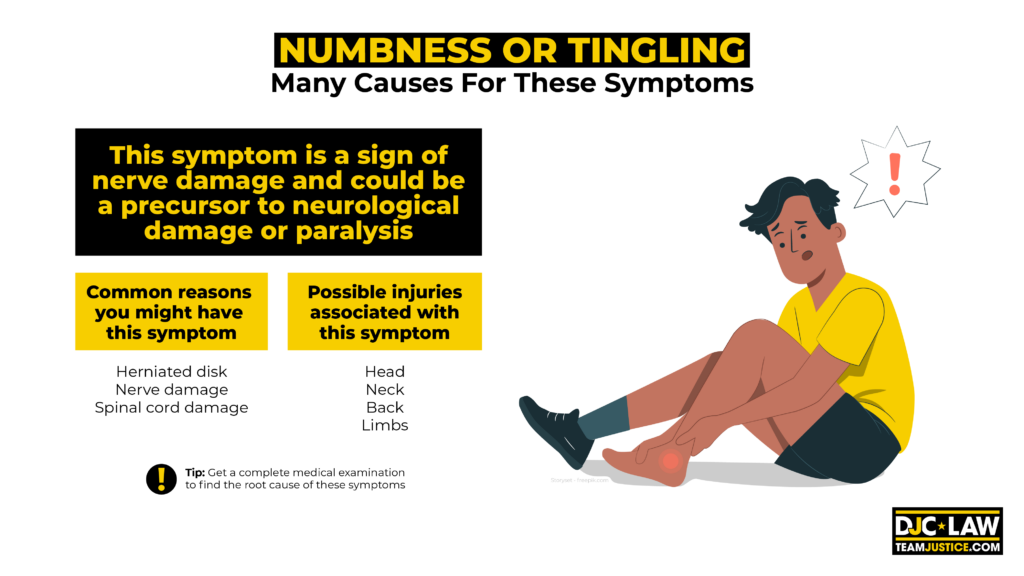
Numbness or tingling in any part of your body after a car accident is a sign of nerve damage and could be a precursor to neurological damage or paralysis. Immediate treatment is necessary, or it could result in a long-term disability.
The most common reasons you might have numbness or tingling are a herniated disk, nerve damage, or spinal cord damage. The problem is they could indicate serious injuries to the head, neck, back, or limbs, meaning the only way to find out for sure is to get a comprehensive medical examination.
7. Internal Bleeding
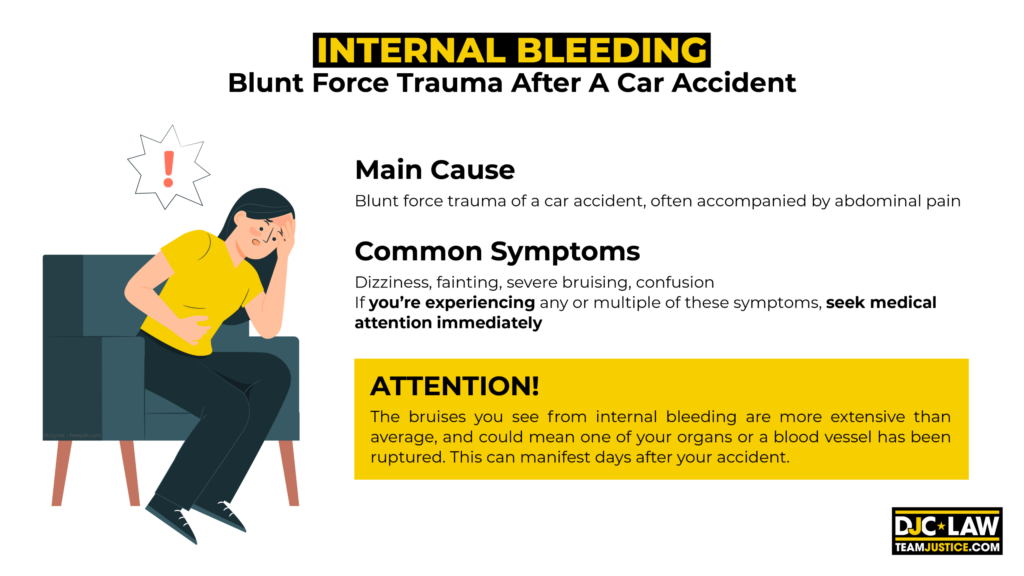
Internal bleeding is caused by the blunt force trauma of a car accident and is often accompanied by abdominal pain. This could even be caused by your seat belt, which may be forced into your abdomen, causing muscle injuries and damage to your internal organs.
All types of internal bleeding are a medical emergency and potentially life-threatening. If you experience dizziness, fainting, severe bruising, or confusion, seek medical attention immediately.
More specifically, the bruises you see from internal bleeding aren’t the same as those from scuffing your knee. These bruises are more extensive than average and extremely dark. Unfortunately, internal bleeding could mean one of your organs or a blood vessel has been ruptured.
Note that internal bleeding may not manifest itself until days after your accident.
8. Abdominal Pain
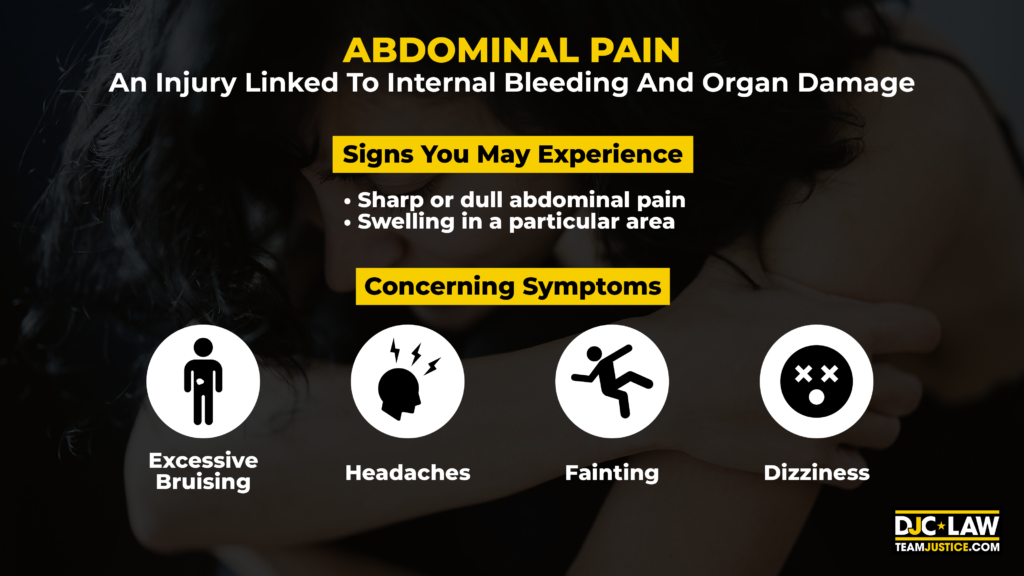
Abdominal pain is caused by the blunt force trauma of a car accident and the force moving its way through your body. You may experience sharp or dull abdominal pain, or you may see some swelling in a particular area. It’s an injury linked to both internal bleeding and serious organ damage.
Like internal bleeding, abdominal pain may not properly surface for a few days. Likewise, you may experience some minor pain that progressively gets worse as the days go by. Some of the most concerning symptoms of abdominal pain include:
Excessive bruising
Headaches
Fainting
Dizziness
Early diagnosis is crucial with any form of abdominal pain after a car crash. Quick intervention could well save your life.
9. Blood Clots
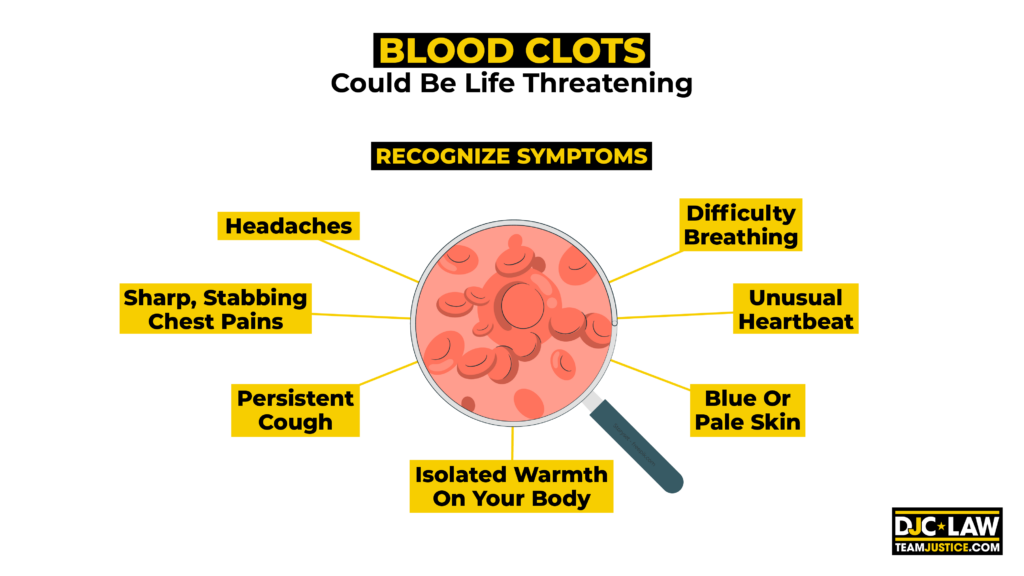
Blood clots (also known as deep vein thrombosis) are your body’s natural reaction to prevent excessive bleeding. Most blood clots are removed by the body itself, but clots can break off and cause pulmonary embolism, which is life-threatening.
It’s normal for blood clots to develop after the severe trauma of a car accident. They’re not a big deal on their own, but if they reach the heart or lungs, your chances of surviving drop dramatically because they cut off your circulation.
Recognizing the symptoms is crucial, including:
Headaches
Sharp, stabbing chest pains
Persistent cough
Difficulty breathing
Unusual heartbeat
Blue or pale skin
Isolated warmth on your body
Blood clots that result in symptoms are a medical emergency requiring an immediate 911 call.
10. Soft Tissue Injury
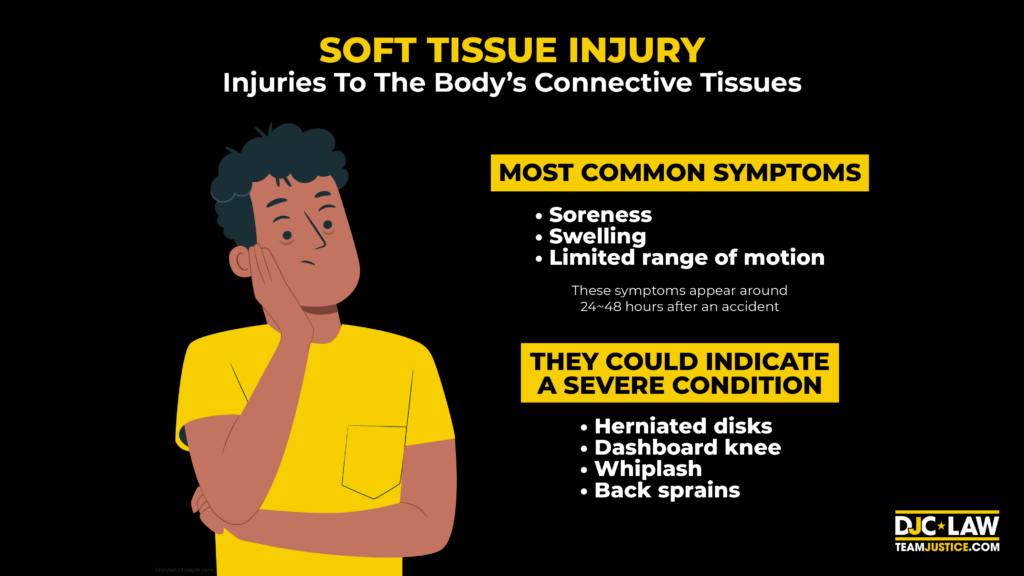
Soft tissue injuries are injuries to the body’s soft or connective tissues. These injuries encompass a wide range of injuries, including bruising, whiplash, sprains, and muscle strains. They can arise practically anywhere on your body but are commonly associated with the neck and spine after a car accident.
The most common symptoms of a soft tissue injury include soreness, swelling, and limited range of motion. Most soft tissue injury symptoms appear around 24-48 hours after an accident.
These injuries may clear up on their own, but they could indicate a severe condition, such as:
Herniated disks
Dashboard knee
Whiplash
Back sprains
11. Post-Traumatic Stress Disorder (PTSD) and Other Psychological Symptoms
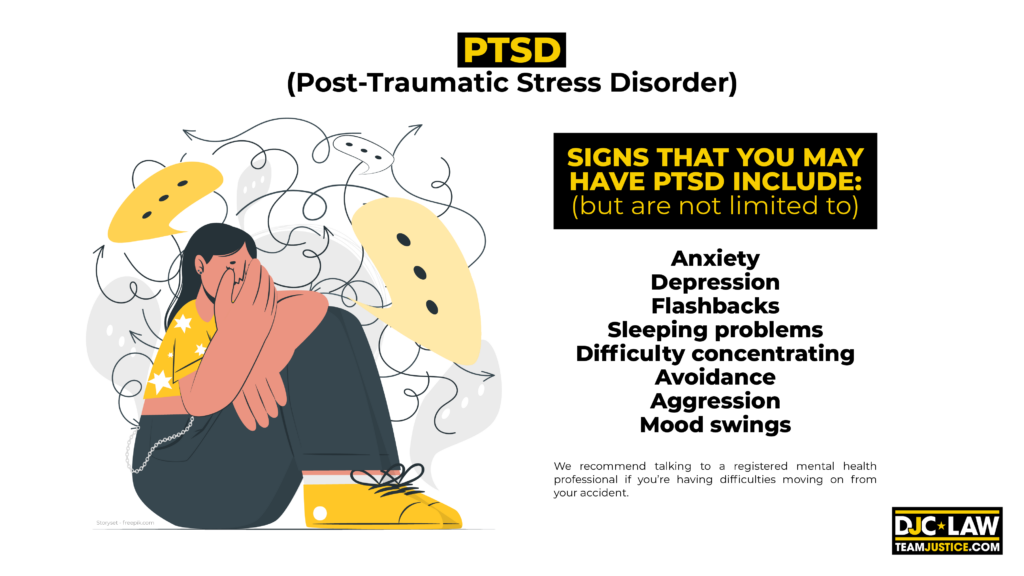
Car accidents are traumatic, meaning you could be at risk of psychological problems, including anxiety, depression, and Post-Traumatic Stress Disorder (PTSD). Mental health problems should be treated with a therapist to avoid them becoming chronic.
Can you get PTSD from a car accident?
According to the National Institutes of Health, individuals involved in serious car accidents suffer from an increased risk of psychological problems, with an emphasis on PTSD. Any potentially traumatic event could trigger these issues, and car accidents are no exception.
Signs that you may have PTSD include but are not limited to:
Anxiety
Depression
Flashbacks
Sleep disturbances
Difficulty concentrating
Avoidance
Aggression
Mood swings
- Excessive sleeping
PTSD is a natural reaction to a traumatic event, and some people fight through it without help. However, others live with PTSD for years, letting it rule their lives and negatively affect their personal relationships. We recommend talking to a registered mental health professional if you’re having difficulties moving on from your accident.
What Should You Expect Physically and Mentally After Being in an Auto Accident?
After a car accident, your body’s response is shock combined with a surge of adrenaline. In the immediate aftermath of an accident, you may feel perfectly fine. Still, within hours, you’ll start to feel the extent of your injuries, followed by psychological symptoms in the weeks afterward.
Your natural reaction to trauma is alertness, a spike in energy levels, and a heightened sense of protection. That’s why you don’t feel pain and discomfort when you’re by the side of the road. Instead, your body only detects these injuries after the adrenaline disappears.
In the short term, you may only notice physical injuries like bruises, cuts, and other types of visible injury, but hours later, musculoskeletal pain and other internal injuries may arise. This is when you should seek immediate medical attention because early intervention is the best way to preserve your health.
Some car accident victims may not grasp the full extent of what they’ve experienced mentally until days or weeks later. In these cases, they find that they have trouble sleeping or may replay the moment before the crash over and over again. Some people won’t even get into vehicles as drivers or passengers because they’re scared.
Everything you feel mentally and physically is a natural result of experiencing a traumatic event. However, burying your head in the sand isn’t the answer. The sooner you identify severe injuries, the better chance you have of doing something about them. With the help of your doctor, legal team, and friends and family, you can begin putting your life back together.
If you’re only now starting to feel the effects of your accident, you’re not alone—and you’re not too late. DJC Law knows how to build cases around delayed symptoms, and we’re ready to help you protect your rights from day one. Call now for a free, no-pressure case review with an attorney who understands what you’re going through.
How Long Does Trauma from a Car Accident Last?
Trauma is often the biggest takeaway from car accidents for accident victims. The symptoms of trauma could go away within weeks, but they could also last for years if you were in a serious accident and didn’t seek treatment.
Everyone reacts to trauma differently. According to Forbes, PTSD symptoms may go away in weeks or months, but others may still have symptoms for years. There’s no reliable way to predict how long a particular individual may carry their trauma.
What are the symptoms of delayed shock after an accident?
Delayed shock is another term for onset PTSD. Onset PTSD displays both physical symptoms, including constant headaches, and emotional symptoms, like depression and mood swings.
Everyone processes traumatic events differently, which can mean you might have some symptoms but not others. Likewise, some symptoms may come and go.
Some of the most common symptoms include:
Unexplained aches
Unexplained pain
Severe headaches
Digestive issues
Memory problems
Concentration difficulties
Anxiety
Depression
What if my medical bills are more than my settlement?
Long-term care for physical and emotional issues can put severe financial strain on your family, which your settlement is supposed to cover in the short term and the long run. But many people are left asking, “What if my medical bills are more than my settlement?” and there’s no easy answer.
Firstly, you may have the option of lodging additional legal action against another party, such as the at-fault driver personally or their insurer. On the other hand, you may be able to ask your insurer to cover excess medical costs or negotiate your bills down with the help of a personal injury lawyer.
Remember, if you’ve already accepted a settlement, you can’t sue the same person twice for the same incident. That’s why it’s essential to work with a lawyer who can win you an appropriate settlement.
What are the Legal Implications of Delayed Symptoms After Car Accident Trauma?
Delayed symptoms aren’t an issue if they arise in the days and weeks after your accident because your lawyer has plenty of time to account for these when building your case. However, issues like pain and suffering can be tricky because the true extent may not reveal itself until months later.
Your delayed symptoms can still be factored into your case, but you’ll need to show evidence to prove them, such as:
Medical documents
Medical bills
Loss of wages
Inability to return to everyday life
Loss of companionship
Loss of quality of life
That’s why we recommend staying in constant touch with your Austin personal injury lawyer and medical team. Undergoing regular evaluations is critical to catching delayed symptoms early and incorporating them into your case.
If you accept a settlement and experience problems later, this complicates matters. That’s why we recommend never fighting your own case or accepting the first offer that you receive.
Is it worth hiring a personal injury lawyer?
Hiring a personal injury lawyer is crucial if you’re seeking a settlement after a car accident that wasn’t your fault. So, is it worth hiring a personal injury lawyer and giving up a portion of your award in fees?
According to Nolo, a personal injury lawyer wins an average of 3.5-4x the settlement of someone who decides to seek a settlement without legal counsel. Why? Here’s some of the value a personal injury lawyer provides:
Build Your Case – Personal injury attorneys are experts in gathering evidence and building your case, ensuring that they leave no stone unturned in your pursuit of the maximum settlement.
Knowing the Tricks – They know how to deal with your auto insurance company and evade the tricks they try to pull to get you to accept a lower settlement than you deserve.
Medical Network – Lawyers can often point you toward the best medical care. They can then unpick all the relevant documentation to contribute to your case.
Legal Expertise – Filing a case requires a mountain of paperwork, and making a mistake could cause you to miss out on the statute of limitations, thus preventing you from claiming compensation at all.
Courtroom Battles – Few cases ever make it into a courtroom, but if yours does, you want someone by your side who can guide you through the process. Court trials are traumatic and difficult, but your attorney will prep you for everything to come.
In short, you’ll get a higher settlement and have someone who can guide you every step of the way. In the meantime, you can focus on healing from your injuries and putting your life back together.


